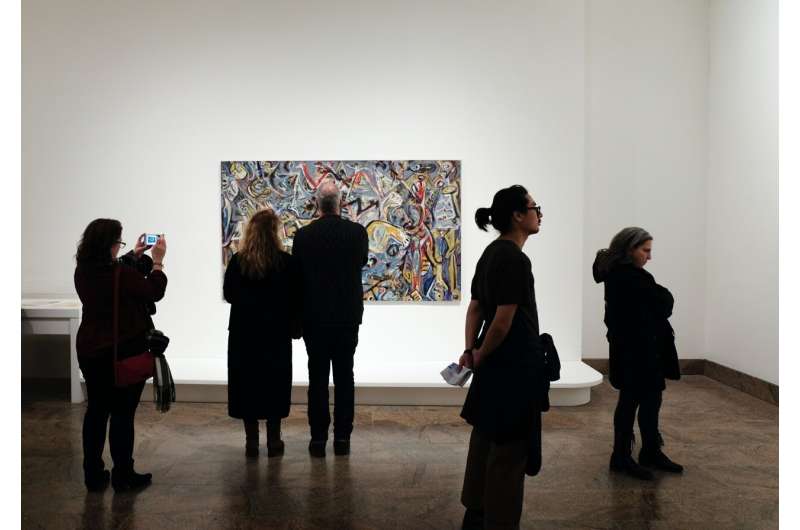Detailed descriptions of modern art may enhance the viewer experience
Visitors to a modern art museum lingered in front of artworks longer and exhibited more signs of excitement when given detailed descriptions of each piece compared to seeing basic labels, according to a study published May 3, 2023, in the open-access journal PLOS ONE by Serena Castellotti from the University of Florence, Italy, and colleagues.
Improving the cultural and aesthetic experience of non-expert visitors is a critical task for art museums. In this study, the authors examined how museum-provided descriptions of art might influence a visitor’s experience of the art.
Thirty university students visited a modern art museum once and were given basic descriptions of each artwork (i.e., author, title, year, and technique). About one month afterward, ten participants returned and repeated the first visit exactly, while twenty participants returned and were given more detailed descriptions of each artwork, including its background and meaning.
The twenty experimental participants spent significantly more time viewing each artwork during their second museum visit (with new, detailed descriptions) as compared to their initial visit. In contrast, the ten control participants spent significantly less time in the museum on their second visit (when given the same basic descriptions as before).
The experimental participants also exhibited physical signs of excitement—dilated pupils and increased skin electrodermal activity. Experimental participants described themselves as experiencing more positive and fewer negative emotions during their second visit, and the artworks as more comprehensible and less complex. However, they didn’t tend to change initial assessments of their aesthetic appreciation for each artwork, even after receiving the more detailed description.
The authors note these effects might be specific to modern art, which tends to be less familiar and perhaps less approachable for the average person than classical art. The findings suggest that museum visitors might benefit from modern art labels with more detail or explanations around the artwork, technique, and/or artist.
The authors add, “Reading detailed information about artworks leads to psychophysiological and behavioral changes, suggesting higher comprehension and liking and a more satisfying aesthetic experience.”
More information:
Psychophysiological and behavioral responses to descriptive labels in modern art museums, PLOS ONE (2023). DOI: 10.1371/journal.pone.0284149
Citation:
Detailed descriptions of modern art may enhance the viewer experience (2023, May 3)
retrieved 3 May 2023
from https://phys.org/news/2023-05-descriptions-modern-art-viewer.html
This document is subject to copyright. Apart from any fair dealing for the purpose of private study or research, no
part may be reproduced without the written permission. The content is provided for information purposes only.

Visitors to a modern art museum lingered in front of artworks longer and exhibited more signs of excitement when given detailed descriptions of each piece compared to seeing basic labels, according to a study published May 3, 2023, in the open-access journal PLOS ONE by Serena Castellotti from the University of Florence, Italy, and colleagues.
Improving the cultural and aesthetic experience of non-expert visitors is a critical task for art museums. In this study, the authors examined how museum-provided descriptions of art might influence a visitor’s experience of the art.
Thirty university students visited a modern art museum once and were given basic descriptions of each artwork (i.e., author, title, year, and technique). About one month afterward, ten participants returned and repeated the first visit exactly, while twenty participants returned and were given more detailed descriptions of each artwork, including its background and meaning.
The twenty experimental participants spent significantly more time viewing each artwork during their second museum visit (with new, detailed descriptions) as compared to their initial visit. In contrast, the ten control participants spent significantly less time in the museum on their second visit (when given the same basic descriptions as before).
The experimental participants also exhibited physical signs of excitement—dilated pupils and increased skin electrodermal activity. Experimental participants described themselves as experiencing more positive and fewer negative emotions during their second visit, and the artworks as more comprehensible and less complex. However, they didn’t tend to change initial assessments of their aesthetic appreciation for each artwork, even after receiving the more detailed description.
The authors note these effects might be specific to modern art, which tends to be less familiar and perhaps less approachable for the average person than classical art. The findings suggest that museum visitors might benefit from modern art labels with more detail or explanations around the artwork, technique, and/or artist.
The authors add, “Reading detailed information about artworks leads to psychophysiological and behavioral changes, suggesting higher comprehension and liking and a more satisfying aesthetic experience.”
More information:
Psychophysiological and behavioral responses to descriptive labels in modern art museums, PLOS ONE (2023). DOI: 10.1371/journal.pone.0284149
Citation:
Detailed descriptions of modern art may enhance the viewer experience (2023, May 3)
retrieved 3 May 2023
from https://phys.org/news/2023-05-descriptions-modern-art-viewer.html
This document is subject to copyright. Apart from any fair dealing for the purpose of private study or research, no
part may be reproduced without the written permission. The content is provided for information purposes only.
